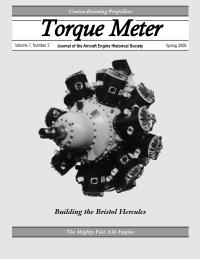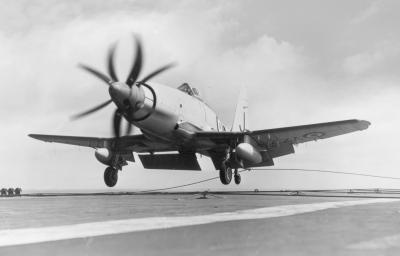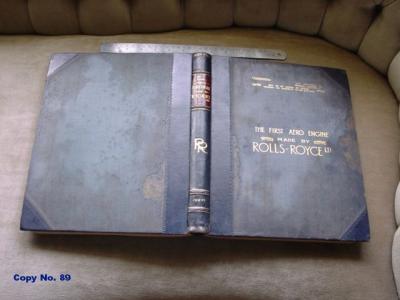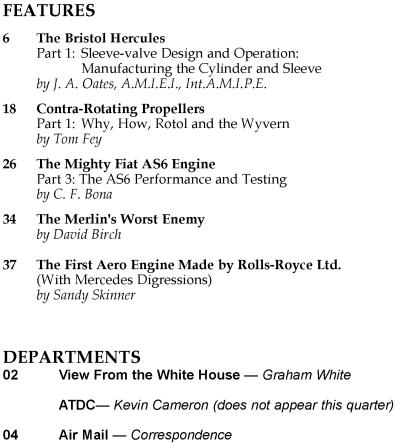
Torque Meter
Spring 2008 Issue
 |
 |
Contra-Rotating Propellers, Part 1: Why, How, Rotol and the Wyvern As engine power increased towards the end of the 1940s and with the advent of even more powerful turboprops, the ability of propellers to absorb the rising horsepower became limited by diameter and blade loadings. Larger props mean taller, more complicated landing gear, and propeller blades, like wings, have structural and efficiency limits with respect to their loadings. Longer prop blades also risk running into supersonic airflows at their tips, and blades of increased chord are limited by structural and drag considerations. Another alternative is to increase the number of blades, such as the five-blade Rotol propeller on the Sea Fury, the six blades on the Dowty R391 propellers on Lockheed C-130J, or the eight blades on the Hamilton-Sunstrand NP2000 props on the Grumman E-2. More blades, however, tempt aerodynamic interference and wake effects due to reduced spacing between blades. A more complicated and fascinating remedy to power absorption is the use of coaxial, contra-rotating propellers, which are props mounted on concentric drive shafts, rotating in opposite directions. Besides offering a large increase in blade area, the opposing rotation of these propellers eliminate the airframe-swerving torque inherent in a single-rotation propeller. |
|
Aero Engine Drawing |
 |
The Mighty Fiat AS6 Engine, Part 3: The AS6 Performance and Testing by C. F. Bona Preparation and testing of an engine of the AS6 type required a huge number of trials which lasted over a period of almost a year and a half. Prior to testing the complete engine, investigations were carried out on the various parts, namely the cylinder, supercharger, carburettor and on the two engines with and without supercharger. For the tests on the cylinder alone, a section of the crankcase of the AS5 was utilized and a counterweighted crankshaft and a drive for the camshafts were constructed so that the height of the cylinder could be varied thus allowing changes in the compression ratio to be tried. Pistons and cylinder were those of the AS6. Compressed air from the laboratory was used for supercharging, the air being taken from a compressed air tank (provided with safety devices) and led to the carburettor intake. These tests were useful because they provided preliminary data on the fuel mixture, the effect of the degree of supercharging, measurements on the overall thermal balance and on valve temperatures. |
 |
The Merlin's Worst Enemy Part 1 gave us a view of operating conditions in North Africa from the viewpoint of the Packard field reps serving with American units operating the P-40F. Part 2 gives the British view from the head of maintenance operations in the Middle East, Group Captain (later Air Vice-Marshal) Grahame Dawson. His report is supplemented by an extract from a visit report by Cyril Lovesey, Rolls-Royce’s Development and Research Engineer, who visited many of the maintenance and operational units and bases of the RAF and USAAF. Group Captain Grahame Dawson was Chief Maintenance Staff Officer in charge of the Royal Air Force’s aero-engine maintenance in the Middle East in the first half of World War Two. He was one of those people for whom the phrase "can’t do" was not in his vocabulary. Two thousand miles away from Britain and with supplies running the gauntlet of Axis air and naval attacks, it was more often the case of make do with what you have and think of something when you have nothing. His efforts to keep the RAF’s aircraft flying entailed methods of repair and re-manufacture that would make any respectable engineer wince, but under the circumstances there was no other way. |
 |
The First Aero Engine Made by Rolls-Royce Ltd. This book is probably the best insight ever printed into the thought processes of a great designer. It is a compilation of the memos sent at the start of WWI by Frederick Henry Royce (henceforward R: see Appendix 2 on Rolls-Royce naming conventions) from the south coast of England to the Derby works. They cover the inception, design and development of the Eagle engine with passing mentions of what became the Hawk and the Falcon. It is important not just for the insight it gives into R’s thinking, but because it adds to our understanding of design and production methods at a time when hand fettling was slowly giving way to batch, if not mass, production. It also shows a more sympathetic and broadminded R than the hire and fire autocrat of legend. The book is often, if improperly, called the Rolls-Royce bible. If that great Company has one failing, it’s a tendency to be pompous. The cover bears the intimidating instruction: CONFIDENTIAL The preface is a classic of its time and worth quoting verbatim. "In the opinion of the Board of Directors, the Memoranda and Letters written by Mr. F. H. Royce, the Engineer-in-Chief in connection with the design, testing and manufacture of these Engines, are so admirable as evidence of extreme care, foresight, and analytical thought, that the Directors decided to have them printed and bound in order that copies may be available for study and as an example to all grades of Rolls-Royce Engineers, present and future." |
